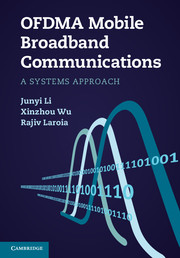Book contents
- Frontmatter
- Dedication
- Contents
- Foreword
- Preface
- List of Notation
- List of Abbreviations
- 1 Introduction
- 2 Elements of OFDMA
- 3 System design principles
- 4 Mitigation and exploitation of multipath fading
- 5 Intra-cell user multiplexing
- 6 Inter-cell interference management
- 7 Use of multiple antennas
- 8 Scheduling
- 9 Handoff in IP-based network architecture
- 10 Beyond conventional cellular frameworks
- A Overview of system operations
- B OFDM point-to-point communications
- C Brief review of channel capacity
- References
- Index
8 - Scheduling
Published online by Cambridge University Press: 05 July 2013
- Frontmatter
- Dedication
- Contents
- Foreword
- Preface
- List of Notation
- List of Abbreviations
- 1 Introduction
- 2 Elements of OFDMA
- 3 System design principles
- 4 Mitigation and exploitation of multipath fading
- 5 Intra-cell user multiplexing
- 6 Inter-cell interference management
- 7 Use of multiple antennas
- 8 Scheduling
- 9 Handoff in IP-based network architecture
- 10 Beyond conventional cellular frameworks
- A Overview of system operations
- B OFDM point-to-point communications
- C Brief review of channel capacity
- References
- Index
Summary
In general scheduling addresses two problems:
• User selection: which users to transmit in the uplink or receive in the downlink.
• Resource allocation: what time-frequency bandwidth to be allocated to the selected users and what transmit power to be used.
Good scheduling strives to achieve two goals, namely quality of service (QoS) on the user level, measured by data rate, delay, loss, and fairness among users, and efficiency on the system level, measured by the total amount of traffic supported by the system.
A key feature in an OFDMA mobile broadband cellular system is scheduling by which a base station dynamically selects users and allocates time-frequency-power resource to them. In contrast, when a user is admitted to the system in a circuit-switched voice system, it is statically assigned a piece of bandwidth resource (time, frequency, or code) over which the voice traffic is transported without explicit dynamic scheduling. In a CDMA voice system, for example, the only dynamic resource allocation job is power allocation or power control [168]. The situation is quite different in mobile broadband, because data traffic is bursty and has different QoS requirements. Static resource allocation cannot simultaneously meet the QoS requirements and achieve high system efficiency. Scheduling becomes a necessity to dynamically match user selection and resource allocation with traffic needs and wireless channel conditions. On the other hand, scheduling has been well studied in wireline broadband networks (see [13, 137]), and many of those design and analysis ideas are applicable to the wireless counterpart.
- Type
- Chapter
- Information
- OFDMA Mobile Broadband CommunicationsA Systems Approach, pp. 282 - 314Publisher: Cambridge University PressPrint publication year: 2013



